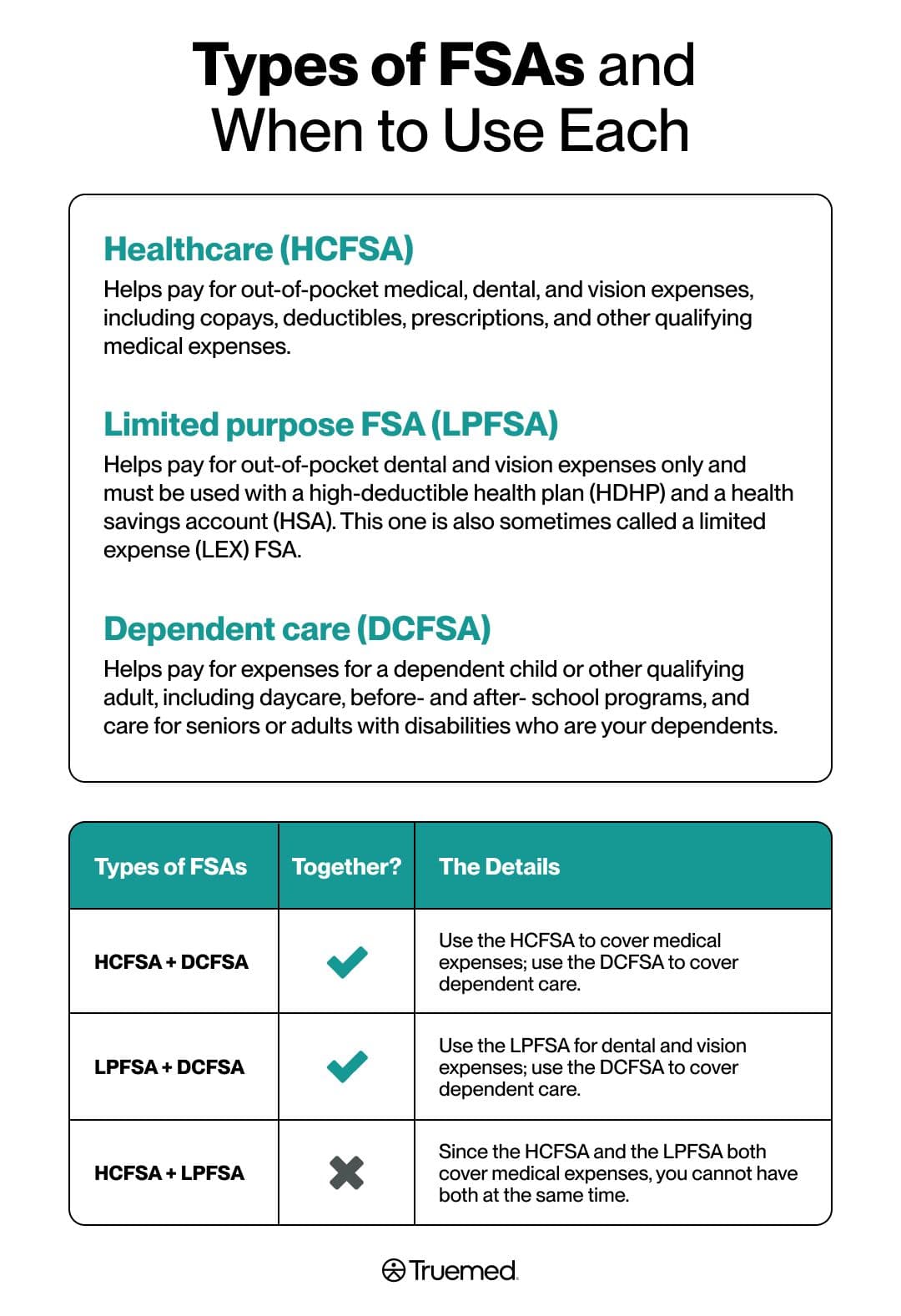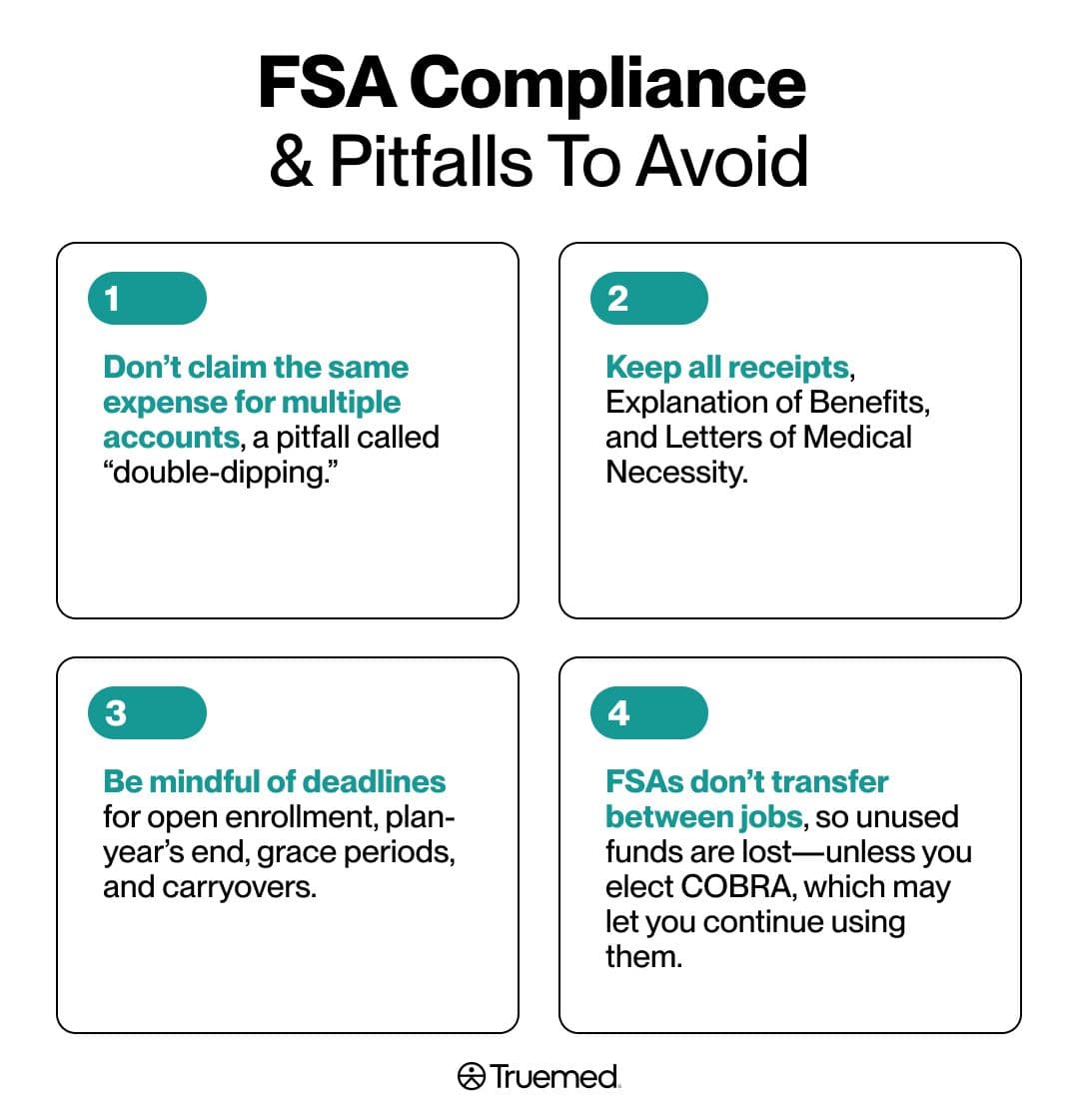How Does an FSA Work? What You Need to Know
Author:Jennifer Chesak
Reviewed By:Michaela Robbins, DNP
Published:
November 11, 2025

What Is an FSA?
Types of FSAs and When to Use Each
Eligibility, Enrollment, and Changing Elections
Contributions and Tax Basics
Spending Your FSA: Cards, Reimbursements, and Receipts
Use-It-or-Lose-It, Grace Periods, and Carryovers
What’s Eligible and What Often Needs an LMN?
Coordination Scenarios (FSAs and other accounts)
Compliance & Pitfalls To Avoid
Key Takeaways
FAQ
How Does an FSA Work? What You Need to Know
A flexible spending account (FSA) is a nifty employer-sponsored benefit that allows you to use your pre-tax dollars for qualifying medical or dependent-care expenses. Learn all about FSAs, including what you can spend your dollars on. And yes, some expenses that don't automatically count — like a gym membership or certain supplements—may be eligible when used to treat a specific health condition and supported by a Letter of Medical Necessity (LMN) for qualified customers.
Medical expenses can add up fast, whether for health insurance copays, deductibles, prescription medications, dental visits, and more.
Plus, all those medically necessary things you buy over-the-counter to alleviate random symptoms that crop up, or to keep yourself and your family feeling well, can also take a toll on your finances. If you have a period, menstrual products can also put a hit out on your wallet. Then add in childcare expenses, including preschool and daycare, and—well, you get the idea. Life can be unexpectedly expensive.
One way to help ease the burden on your bank account is to use pre-tax dollars from your paycheck to pay for medical or dependent care expenses. You can do this with a specific employee benefit if your employer provides it.
“A flexible spending account (FSA) is undoubtedly one of the simplest, yet most underutilized, methods of lowering taxable income,” says Christopher Migliaccio, a business and regulatory compliance attorney and founder of Warren & Migliaccio, LLP.
In addition to the tax benefits of an FSA, experts say this benefit can help empower patients to take charge of their health. “It pushes individuals into making preventive and elective health choices that enhance their quality of life,” says Gregg Feinerman, MD, a board-certified eye surgeon and medical director of Feinerman Vision.
In this article, we explore what an FSA is, how it works, the different types, what expenses are eligible, and more.
What Is an FSA?
At one time or another you’ve probably looked at your paycheck withholdings that go toward paying taxes and wished you could access some of that hard-earned cash. Well, an FSA may be just the ticket you need to put that money to work for you.
Your employer may offer an FSA as a benefit. This allows you to contribute some of those pre-tax dollars to an account that you can then use to pay for—or get reimbursed for—qualifying expenses.
In doing so, you’ll save on how much you pay toward taxes. According to the federal government, many FSA users save an average of around 30% by spending pre-tax dollars. HSA/FSA tax savings vary. Learn more at truemed.com/disclosures.
Types of FSAs and When to Use Each
Not all FSAs are the same. Depending on what your employer offers, you may be offered one or more of three options.
Despite their differences, says Grant Meyer, CFP, BFA, a financial advisor and the founder of TruMix Advisors, “All three flavors of FSAs have the same benefit—tax savings.”
FSA types:
- Healthcare (HCFSA): Helps pay for out-of-pocket medical, dental, and vision expenses, including copays, deductibles, prescriptions, and other qualifying medical expenses.
- Limited purpose FSA (LPFSA): Helps pay for out-of-pocket dental and vision expenses only and must be used with a high-deductible health plan (HDHP) and a health savings account (HSA). This one is also sometimes called a limited expense (LEX) FSA.
- Dependent care (DCFSA): Helps pay for expenses for a dependent child or other qualifying adult, including daycare, before- and after- school programs, and care for seniors or adults with disabilities who are your dependents.
<<<<<<<TABLE GOES HERE>>>>>>

Eligibility, Enrollment, and Changing Elections
If you’re considering adding an FSA, you must first determine if you’re eligible. If so, you can enroll.
Eligibility
Your eligibility generally comes down to whether you have an employer and whether they offer this employer-sponsored benefit. If you are self-employed, you are not eligible for an FSA. However, if you’re married, your spouse’s employer may offer one that benefits your household.
Enrollment
The tail end of each year features an open enrollment period. This typically coincides with health insurance plan open enrollment. The dates may vary based on your employer and insurance plan, but open enrollment typically starts in November and may last into the first half of January.
During open enrollment, you can opt in to an FSA if your employer offers this benefit. In some cases, you may qualify for a special enrollment period at other times throughout the year if you experience a qualifying life event, such as getting married, having a new baby, adding another dependent, moving, changing jobs, and more, etc.
Changing elections
If you opt in to an FSA, you then choose how much money you want to contribute to your account for the next year to be used for qualifying expenses. Each year, during open enrollment, you can change how much you want to contribute.
Contributions and Tax Basics
One of the biggest benefits of having an FSA is that your contributions to the account reduce your federal income tax burden. This means you pay less in taxes and get to put a portion of what would normally be withheld from your paychecks for taxes toward medical or childcare expenses, depending on the type of FSA you have.
You can use the U.S. government’s calculators to determine how much you can save—based on your general spending for qualifying medical expenses and more.
Contribution limits
FSAs are subject to IRS contribution limits:
<<<<<<<TABLE GOES HERE>>>>>>
How contributions work
You choose the amount you want to contribute to your FSA for the full year, staying within contribution limits. Your employer will then fund the account in one of two ways, depending on the type of FSA you have.
Contribution methods:
- Front-loading: With an HCFSA and LPFSA, your employer will place your chosen contribution amount in your FSA at the beginning of the year, and you have access to these funds right away. Your employer will then withhold a portion of your pre-tax income with each paycheck to reimburse their front-loading of your account.
- Progressive funding: For a DCFSA, your employer will withhold a portion of your pre-tax income from each paycheck and place that in your FSA. You accrue these funds in your account throughout the year rather than all at once, and you can only use the funds that are already in the account.
In addition to your own contributions, your employer might also choose to contribute to your FSA, but methods vary based on which FSA you have. They might contribute a lump sum or match your contributions. Employer contributions are subject to IRS limits, as well.
Employer contributions:
HCFSAs and LPFSAs: The total annual benefit, meaning your contribution plus any employer contributions, cannot exceed the greater of:
- A. Twice your own contribution
- B. Your contribution plus $500
<<<<<<<TABLE GOES HERE>>>>>>
DCFSAs: Your employer can contribute $7,500 per year if you are married and filing jointly or a single parent. Or they can contribute $3,750 per year if you are married and filing separately.
Spending Your FSA: Cards, Reimbursements, and Receipts
Once you have an FSA in place, you can spend the money on qualifying medical expenses. You can use your plan-issued debit card tied to your FSA to pay for expenses directly. Or you can get reimbursed from your FSA for medical expenses after you’ve paid them with any of your usual personal accounts, such as checking, savings, or a credit card.
Always keep your receipts for paid medical expenses and your explanation of benefits (EOBs) from your health plan. Your health insurance plan should provide you with your EOBs via regular mail or as electronic documents in your online account if you’ve elected to receive paperless correspondence.
Use-It-or-Lose-It, Grace Periods, and Carryovers
FSAs require some strategic planning to ensure you spend all or the bulk of the funds you contribute each year.
Use-it-or-lose it
With an FSA, you generally must use it or lose it. This means that if you don’t spend the money within the year, you forfeit that amount. However, some HCFSA and LPFSA plans have either a grace period or a carryover. DCFSAs do not feature either of these options.
Grace periods
For HCFSAs and LPFSAs, some employers allow for a grace period of up to 2.5 months after the plan year’s end for you to spend the remaining dollars in your account.
For example, if your plan ends on the last day of the year, you might have a grace period lasting until March 15. So if you contributed $3,400 for the previous year and you have $400 remaining in the account at year’s end, you would still be able to spend that $400 if you do so by mid-March.
Carryovers
Instead of grace periods, some plans allow for an automatic carryover, meaning funds left in your HCFSA or LPFSA account can be spent in the following year at any time. Carryovers are subject to IRS maximums. The maximum amount you can “roll over” into 2026 is $610.
Your employer cannot offer both a grace period and a carryover option—only one or the other, and they might not offer these options at all.
What’s Eligible and What Often Needs an LMN?
You might be wondering what you can pay for with your FSA dollars. So let’s take a look.
Qualifying medical expenses for HCFSAs:
- Medical services and treatments as part of your deductible, copay, or coinsurance, including payments for appointments and services with a provider or hospital
- Prescription medications
- Over-the-counter items, such as pain relievers, antacids, menstrual care products, etc.
- Medical equipment and supplies, such as hearing aids, crutches, supplies for diabetes management, blood pressure cuffs, etc.
- Vision and dental care
- Miscellaneous medically necessary expenses
Qualifying medical expenses for LPFSAs:
- Dental care, including cleanings, X-rays, fillings, crowns, root canals, braces, retainers, dentures, etc.
- Vision care, including eye exams, prescription lenses and frames, contacts and solutions, and corrective eye surgery
Qualifying medical expenses for DCFSAs:
- Childcare for children under 13 (while you work or look for work)
- Care for other dependents, including adult day care (while you work or look for work)

What about items not on these lists?
In many cases, medically necessary items you use in your everyday life to manage diagnosed conditions are not considered qualifying medical expenses under the usual rules.
“A letter of medical necessity [LMN] is required when an expense does not fall under normal eligibility—for instance, massage therapy or special pieces of equipment—to ensure IRS compliance,” Migliaccio says.
An LMN is a formal document from a licensed healthcare provider that explains why a certain product, treatment, or service is necessary to treat, mitigate, or prevent a medical condition.
Plenty of health products and services may be HSA/FSA eligible with a Truemed LMN for qualified customers. Think gym memberships, personal home gym equipment (like that stationary rower you’ve been eyeing), and that growing list of prospective supplements.
How It Works with Truemed
Truemed specializes in helping you maximize your FSA and other health-related benefits.
- First, you can check whether a product or service is normally considered a qualifying medical expense or whether you might need an LMN.
- If an LMN is appropriate, an independent licensed practitioner (via Truemed’s clinical partner) will review your medical history, and if you qualify, they’ll issue the LMN. Truemed itself does not make eligibility determinations.
- You can then pay for qualifying products and services with your FSA’s debit card or get reimbursed for expenses after submitting your LMN and receipts.
- Truemed also offers support in the event you get a denial of reimbursement and need to provide substantiation documentation.
Coordination Scenarios (FSAs and other accounts)
Which types of health-related benefit accounts play well together, meaning they follow IRS rules of compatibility? Good question. You might be curious if you can use an FSA with a health savings account (HSA) or a health reimbursement arrangement (HRA).
<<<<<<<TABLE GOES HERE>>>>>>
*Normally an HCFSA is not compatible with an HSA, because the HCFSA covers all your medical expenses. However, if you have a post-deductible FSA (PDFSA), you can only get reimbursed for expenses that surpass your deductible. So a post-deductible FSA does not violate HSA rules.
Compliance & Pitfalls To Avoid
If you have an FSA, you want to ensure you follow all the rules regarding using it for eligible expenses and more. Here are a few things to keep in mind:
- Don’t claim the same expense for multiple accounts, a pitfall called “double-dipping.” For example, you can’t submit for reimbursement from both an FSA and an HSA, or from both your FSA and your spouse’s.
- Keep all receipts, EOBs, and LMNs.
- Be mindful of deadlines for open enrollment, plan-year’s end, grace periods, and carryovers.
- Remember that FSAs do not move with you if you switch jobs, so you will forfeit the money if you don’t use it before leaving your current employer. However, if you lose your job and elect to use COBRA, a law that allows qualified individuals to continue their employer-sponsored health coverage for a limited period, you may be able to continue accessing your FSA funds.

Truemed is for qualified customers. HSA/FSA tax savings vary. Learn more at truemed.com/disclosures.
What it is:: An FSA is a great way to reduce your tax burden while also paying for qualifying medical expenses.
Availability:: An FSA is only available through your employer or your spouse’s employer.
Strategy:: You must strategize to contribute the right amount and spend it accordingly by specific deadlines.
How Truemed can help:: Truemed can help you maximize your FSA benefits by streamlining the process by which qualified individuals can spend on eligible medical intervention.
Editorial Standards
At Truemed, we believe better health starts with trusted information. Our mission is to empower readers with accurate and accessible content grounded in peer-reviewed research, expert insight, and clinical guidance to make smarter health decisions. Every article is written or reviewed by qualified professionals and updated regularly to reflect the latest evidence. For more details on our rigorous editorial process, see here.


